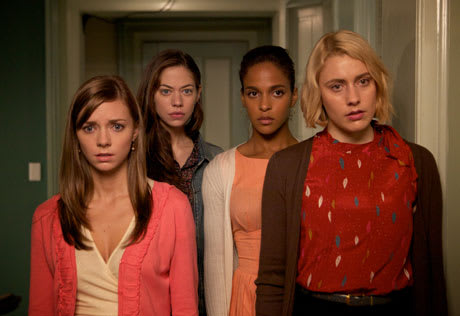Being known for dissecting the lives of educated upper crust youths whose refined verbosity and pretence exacerbate their superficiality and emotional vacancy, Whit Stillman's particular shtick ― a more learned and less hyperbolic, psychotic variation of Bret Easton Ellis ― worked mostly in the context of the '80s. Even after Metropolitan and Barcelona covered that territory with sardonic wit and verbal aplomb, The Last Days of Disco, which came out in 1998, stepped back to rip on the fad of artifice that started it all.
Now, 13 years later, Stillman is again assessing the same demographic, only attributing the sensibilities and dialogue to a group of modern girls at an East coast University that has only just begun accepting female students. The main character distinctions here are that of naïveté and conscious hypocrisy rather than the self-serving venom of Stillman's earlier works, which suggests that his perception of modern superficiality is masked by liberal pretence and genuine ignorance.
Without a great deal of coherence, the story is merely filler for an endless series of conversations and social observations, with the manic Violet (Greta Gerwig) inviting innocent student transfer Lily (America's Next Top Model's Analeigh Tipton) to join her clique of colourfully dressed do-gooders. They help clinically depressed students by teaching them choreographed dance routines and boost the egos and potential of uneducated frat boys by gracing them with their presence.
There's virtually no progress and really no point to anything that happens beyond the aforementioned cultural didactics. But the dialogue is consistently hilarious, making the awkward pacing and dreadful direction somewhat palatable.
It's easy to forgive a movie its flaws when it makes the argument that trying to be an individual and unique is just a monstrous pain in the ass to everyone else, while suggesting that the only lasting thing of benefit a person can contribute to the world is a dance craze phenomenon. Even the tenuous application of the titular "distress" to the primary damsels ― in the form of male playboys and operators ― is amusing, integrating a new religion that believes only in rear-entry coitus.
If all of these clever exchanges and amusing ideas had some sense of narrative structure, Damsels in Distress could have been far more than a passing curiosity. While not a complete failure, Stillman's latest work feels a lot like it was written over a long period of time, with a variety of different mindsets crammed together without much editing.
(Mongrel Media)Now, 13 years later, Stillman is again assessing the same demographic, only attributing the sensibilities and dialogue to a group of modern girls at an East coast University that has only just begun accepting female students. The main character distinctions here are that of naïveté and conscious hypocrisy rather than the self-serving venom of Stillman's earlier works, which suggests that his perception of modern superficiality is masked by liberal pretence and genuine ignorance.
Without a great deal of coherence, the story is merely filler for an endless series of conversations and social observations, with the manic Violet (Greta Gerwig) inviting innocent student transfer Lily (America's Next Top Model's Analeigh Tipton) to join her clique of colourfully dressed do-gooders. They help clinically depressed students by teaching them choreographed dance routines and boost the egos and potential of uneducated frat boys by gracing them with their presence.
There's virtually no progress and really no point to anything that happens beyond the aforementioned cultural didactics. But the dialogue is consistently hilarious, making the awkward pacing and dreadful direction somewhat palatable.
It's easy to forgive a movie its flaws when it makes the argument that trying to be an individual and unique is just a monstrous pain in the ass to everyone else, while suggesting that the only lasting thing of benefit a person can contribute to the world is a dance craze phenomenon. Even the tenuous application of the titular "distress" to the primary damsels ― in the form of male playboys and operators ― is amusing, integrating a new religion that believes only in rear-entry coitus.
If all of these clever exchanges and amusing ideas had some sense of narrative structure, Damsels in Distress could have been far more than a passing curiosity. While not a complete failure, Stillman's latest work feels a lot like it was written over a long period of time, with a variety of different mindsets crammed together without much editing.
